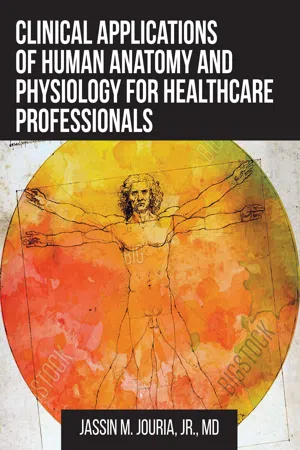
Clinical Applications of Human Anatomy and Physiology for Healthcare Professionals
- 402 pages
- English
- ePUB (mobile friendly)
- Available on iOS & Android
Clinical Applications of Human Anatomy and Physiology for Healthcare Professionals
About this book
Anatomy and Physiology is effectively a broad introductory course that requires the student to devote an enormous amount of effort to understand it on even a basic level. While this necessitates time, it can be streamlined in the early stages of one's learning so that the student may understand why he or she is required to invest such a large amount of time into learning - Clinical Applications of Human Anatomy & Physiology is the textbook that accomplishes this.°Clinical Applications of Human Anatomy & Physiology is a book that combines both areas of knowledge for a full comprehension of the human body. It is targeted to healthcare students in need of a better understanding of human physiology to combine with their clinical training. The main objective of this book is to elucidate the organization and functioning of the major organs and systems with an emphasis on the applications of this knowledge on the daily clinical routine.°One of the main differences of this textbook that sets it apart from others is that it not only provides the information: it also contextualizes it. Every chapter starts introducing a case study that is related to the content that is going to be approached. At the end of the chapter, there is the conclusion of each case study, which presents the final diagnosis showing every step of the process. This context is essential so that, when the student faces this situation in the real-life clinic he or she will be able to deal with it efficiently. Clinical Applications of Human Anatomy & Physiology also has sections of questions to practice the knowledge that was obtained during the chapter, and the answers to each question are explained so no doubts remain after studying. All of this means that Clinical Applications of Human Anatomy & Physiology is a fully rounded book that combines information and practical applications, as well as questions that help the student to understand and retain all the information in a very efficient and effective way. This book has all the information you need to get started on your journey to learning about the human body.
Frequently asked questions
- Essential is ideal for learners and professionals who enjoy exploring a wide range of subjects. Access the Essential Library with 800,000+ trusted titles and best-sellers across business, personal growth, and the humanities. Includes unlimited reading time and Standard Read Aloud voice.
- Complete: Perfect for advanced learners and researchers needing full, unrestricted access. Unlock 1.4M+ books across hundreds of subjects, including academic and specialized titles. The Complete Plan also includes advanced features like Premium Read Aloud and Research Assistant.
Please note we cannot support devices running on iOS 13 and Android 7 or earlier. Learn more about using the app.
Information

- ■ Introduction


- ■ Characteristics of Living Organisms
Table of contents
- Cover Page
- Full Title
- Copyright
- Dedication by Bana Boo
- Dedication by Albert Einstein
- Table of Contents
- Foreword
- Preface
- Acknowledgements
- Chapter 1 - Overview of Human Anatomy and Physiology
- Chapter 2 - Cytology
- Chapter 3 - Integumentary System
- Chapter 4 - The Skeletal System
- Chapter 5 - The Muscular System
- Chapter 6 - The Cardiovascular System
- Chapter 7 - The Hematological System
- Chapter 8 - The Lymph atic and Immune Systems
- Chapter 9 - The Respiratory System
- Chapter 10 - The Digestive System
- Chapter 11 - Nutrition and Metabolism
- Chapter 12 - The Urinary System
- Chapter 13 - The Endoc rine System
- Chapter 14 - The Nervous System
- Chapter 15 - The Reproductive System
- Glossary